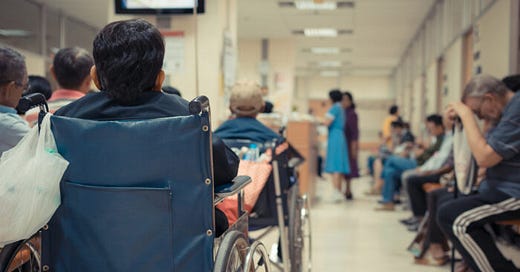Why things are even worse than you think
Official statistics don't tell the full story about the state of public services
I have a feature piece in this month’s Prospect using 13 charts to tell the story of 13 years of government failure. Had they wanted to fill the whole magazine I could have used 100 charts. With a handful of exceptions (exam results, use of renewable energy, workplace pension enrolment) every trend graph is going in the wrong direction. The public sector is in a bad way. Hospitals are at breaking point, the police are charging fewer criminals, prisons are full, most schools have to run food banks, care homes can’t find staff. And so on.
But even this bleak picture puts a gloss on reality because of how institutions react in conditions of scarcity. If demand for a service is higher than providers can manage they will start rationing access more aggressively. This can be done as a deliberate strategy, an ad hoc coping mechanism, or even subconsciously by taking decisions in a different way under pressure. Topline data can hide this rationing because it keeps people away from services, protecting performance measures while piling up problems for the future.
The Real Story of NHS Waiting Lists
The NHS is a great example. The waiting list for elective treatments has risen over the course of the year from 7.2 million to 7.7 million, despite Rishi Sunak’s pledge to bring it down. But there hasn’t been any increase in the numbers joining the list compared to pre-pandemic. There’s no more apparent demand. The rise has been primarily caused by the lack of space in the hospital system, combined with industrial action from doctors (which the Health Foundation estimates has increased waiting lists by around 210,000 cases). It’s only in the last few months that the number of new referrals taken on by hospitals has reached the levels seen in 2019.
This is not what experts thought would happen. The assumption made, when we reached the end of lockdowns in 2021, was that there would be a lot of pent-up additional demand from people who were unable to access treatment during the covid period, when elective treatments dropped dramatically. This is what the IFS anticipated in February 2022 when their central scenario was that waiting lists would be at 8.6 million by now – without doctors going on strike.
Now maybe this hasn’t happened because that apparent pent-up demand wasn’t really there. Perhaps people recovered without medical assistance or found other ways to deal with it. But when you dig into the data it looks more like there is considerable demand suppression going on to try and keep numbers as manageable as possible.
Keep reading with a 7-day free trial
Subscribe to Comment is Freed to keep reading this post and get 7 days of free access to the full post archives.




